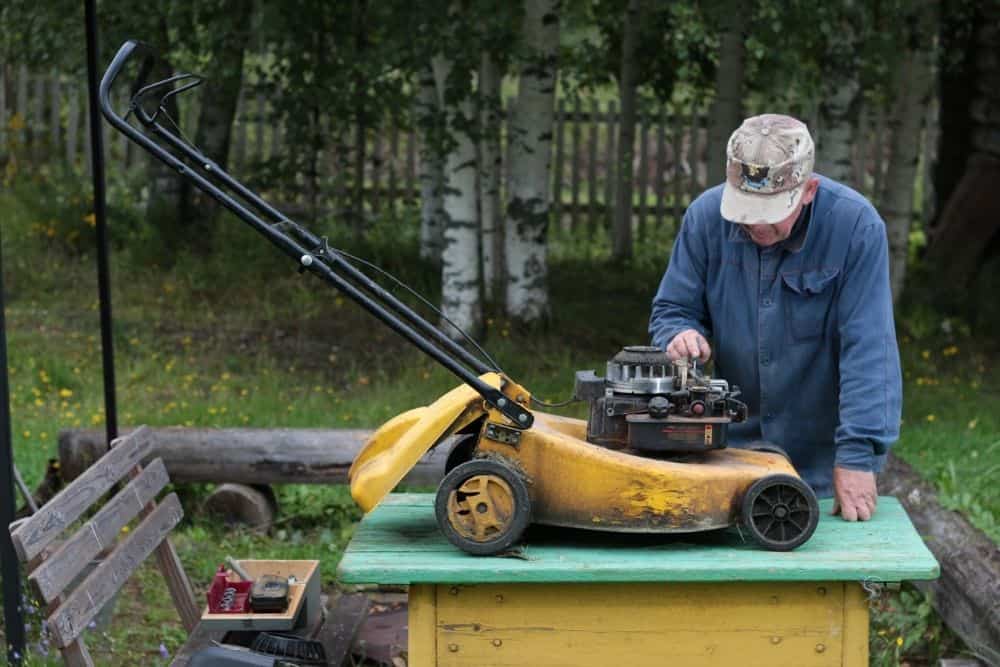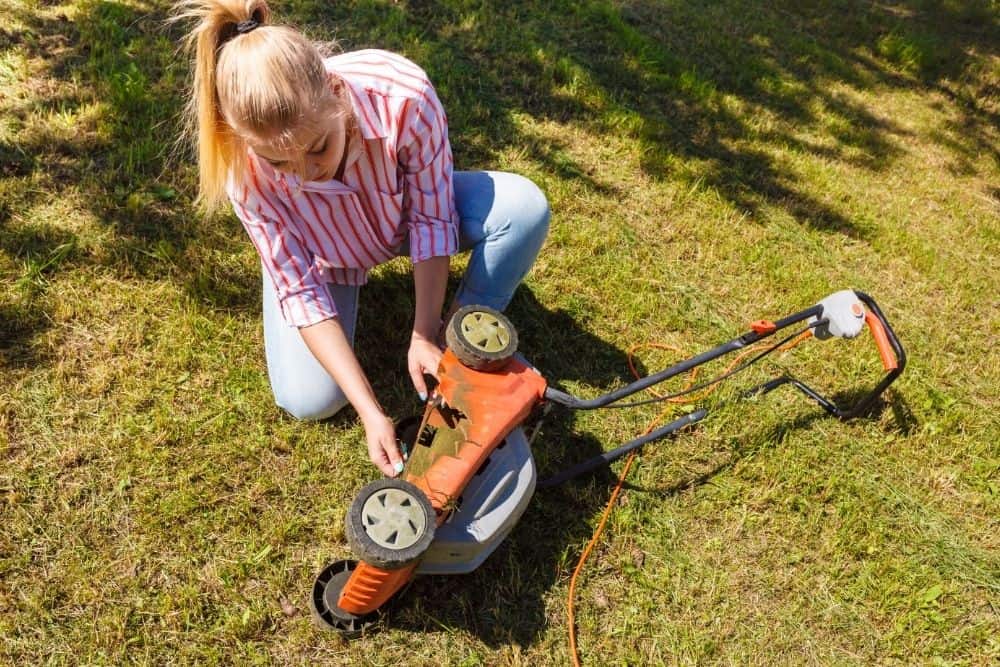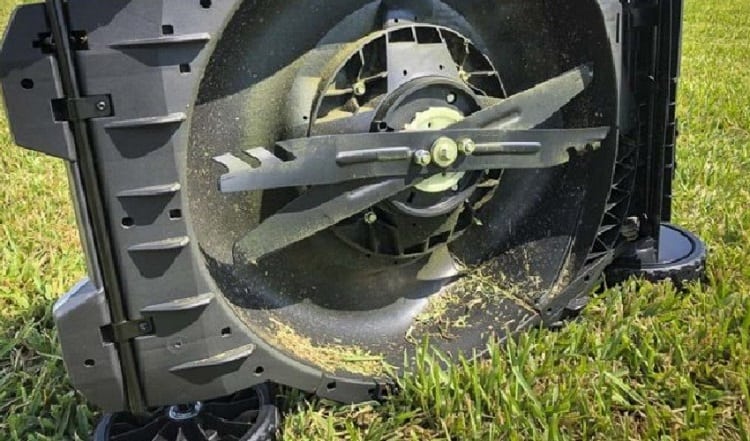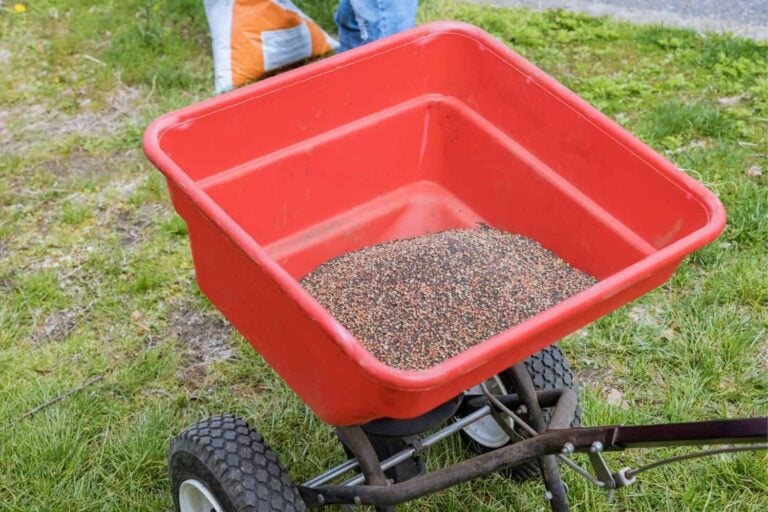My Lawn Mower Starts Then Dies – What’s Wrong?
You only realize your lawn mower is broken when you really need it.
Whether you need to mow your lawn once a month or once a year, nobody wants to wait for a sunny day, break out the lawn mower, and then realize it isn’t working.
Lawn mowers can get expensive too, so getting a replacement isn’t feasible for many people. You shouldn’t rush to get one either, because maybe you can still bring your lawn mower back to life…
That’s what we’re covering today. If your lawn mower has stopped working, you might still be able to get it working again.
It’ll take a little time, some elbow grease, and maybe a replacement part or two, but it’s cheaper than replacing the entire thing.
Here we have four of the most common causes of lawn mower failure, with steps on how to solve each problem.
Causes Of Dying Lawn Mowers
So, your lawn mower starts briefly and then dies. That’s an important detail that will help us ignore other problems, where the lawn mower wouldn’t start in the first place.
We know that your mower can start, it just unceremoniously dies a few seconds later. There are four common causes for this:
- Dirty/Clogged Carburetor
- Dirty/Defective Spark Plugs
- Using Old Gasoline
- Using Too Much Oil
Maybe you have an idea of which one applies to you. You’ll find a breakdown of each problem and how you can solve it below.
Dirty/Clogged Carburetor
If your lawn mower can start and then it suddenly stops, your carburetor may be to blame. Your carburetor takes some punishment no matter where you live.
If your lawn mower is packed away all year round, it may be vulnerable to getting cold. If your lawn mower is being used all year round, it’ll gather the usual wear and tear that might cause mechanical problems in the mower.
What Is The Carburetor?
Maybe you’re not savvy to the parts that are in your lawn mower, so you don’t even know what a carburetor is.
The carburetor is the component that mixes the gas with oxygen to start combustion within the mower engine. That combustion rotates the crankshaft which then enables the lawn mower to move.
The carburetor regulates the flow of gasoline so that the lawn mower runs properly and consistently.
However, if the carburetor is dirty or the bowl of the carburetor is clogged up, the process is interfered with. This means your engine might start-up but, within a few seconds to minutes, it’ll stop.
How To Fix The Carburetor
So, maybe you’ve identified that the carburetor is the problem. In that case, you need to clean it somehow so that it’s clean and as good as new.
You can buy carburetor cleaner in dedicated spray cans. They’re cheap and will last you for quite a while, about a year or two if you use it every time you break out the mower.
Many of them use carbon contaminants that make sure the carburetor stays clean after use, fighting the development of gum and debris that would stop your lawn mower from functioning properly.
People clean the carburetor every time they mow to guarantee the best possible performance. They do this by spraying near the engine air intake hole before starting it up.
If you can’t find that, it’s typically behind the air filter, which you’ll need to remove to get at the hole.
If the cost of the carburetor cleaner is an issue, you can just use it occasionally. You should shop around when buying carburetor cleaner.
If you need a more precise spray, you’ll find that different brands and products offer different nozzles.
If the carburetor bowl is the problem, use the cleaner on it. Clean the area around the bowl too, like the holes for nearby screws.
You’ll probably find it easier if you have a directional spraying nozzle that you can control. Make sure you don’t screw any of the screws too tight when replacing them.
Dirty/Defective Spark Plugs
Without spark plugs, the air/fuel cocktail in your lawn mower’s engine won’t be able to ignite.
So, if your spark plugs are dirty or defective, they’re as good as not having spark plugs at all. They won’t create a spark and so the lawn mower will start and then suddenly stop.
Naturally, the plugs are essential to the operation of your mower. Your mower cannot work without them.
How To Fix Spark Plugs
First, find out where your spark plugs are on the mower. If you’re using a lawn mower that you walk behind, they’re probably at the front.
If you’re tampering with the spark plugs, you’ll need to have a socket wrench handy. Socket wrenches come in different sizes and your mower’s manual should tell you which size is required.
Just from looking at the spark plugs, you should see if they are coated with build-up or not.
Use a wire brush, not a shot-blast cleaner, to clean the spark plugs. Just remove all of the visible build-ups, you don’t need to make them perfect for them to continue working as normal.
However, take a closer look at the spark plug. There’s a difference between build-up and carbon residue, which is a sign that you should replace the plug entirely.
If you’re unsure, you can clean them and then try the lawn mower again. If it works, you’ve solved your problem. If it doesn’t, then you should try replacing them. Fortunately, replacing them is inexpensive.
Removing the spark plug is easy, you should be able to handle it. Unhook the spark plug wire so that the plug can be properly removed.
Putting the spark plug back in is a bit trickier. You’ll need to use a spark plug gauge to measure the distance between the electrodes on the plug.
These vary between spark plug models, so you need to make sure you get the right plugs for your mower. It is possible to slightly curve the electrodes to make them more suitable for your lawn mower.
Once you have the correct plugs, you need to attach the spark plug lead. Don’t fix them too tight or they won’t work.
You can find many videos online that will help you visually navigate spark plug replacements.
Spark plugs should be replaced every few years anyway to prevent lawn mower issues just like this.
If you came here for a different lawn mower problem, consider checking out the spark plugs to make sure they are fine.
Replacing them now might save you trouble in the long run. Change the oil in your mower during maintenance, too.

Using Old Gasoline
Assuming the mechanical parts of your lawn mower are functional, you still need gasoline.
Even if you have gasoline in your mower, the quality of your fuel is very important too. Trying to run on bad fuel is just like using no fuel at all.
Fuel will go bad if it’s left in a stagnant mower for too long.
When that happens, the gasoline evaporates and creates a residue. That residue contains particles that will get caught on the mechanical parts of your mower, affecting its performance.
Sometimes, it can get so bad that gas flow is restricted and the mower starts, gets starved of gas, and then dies shortly after. Your mower may not start at all.
How To Fix Old Gasoline
You can’t reverse old gasoline that has gone bad, so you need to replace it. If only a small amount of bad gas is in the tank, you can try diluting it with new, fresh gas.
Unfortunately, if this doesn’t work then you’ve just wasted some expensive natural resource that you could have used to cut grass.
That’s why we’d recommend you siphon old gas out of the lawn mower’s gas tank.
Siphon it all away and then replace it with fresh gasoline, so you can be confident that you’re working with the best fuel possible.
You may also want to add a stabilizer that prevents the build-up of that harmful residue that makes old gas so bad.
Most of them will stop the residue from appearing for up to two years and they aren’t too expensive to buy, so they’re a great investment into your lawn mowing future.
Read the decorations on the stabilizer to make sure you’re using it properly.
The stabilizer is a must if you’re in wintry climates where your lawn mower is stored away for long periods. That’s where the gasoline goes bad, so the stabilizer will keep it fresh for longer.
If you’re in a warm climate with fast-growing grass, you may be using your lawn mower so often that your fuel won’t go bad.
If your mower is having problems but you use it often, it’s probably not old gasoline, so check out the other issues we’ve discussed on this page.
Using Too Much Oil
Using too much oil in your lawn mower is another possible cause of a sudden stop. In fact, if the lawn mower’s mechanical parts and gasoline are fine, it’s probably the oil that’s causing your problems.
When filling your oil reservoir, make sure you don’t overfill it. Many people trick themselves into overfilling their oil reservoir, thinking that it makes the lawn mower run even better.
Instead, it has the opposite effect. The excessive oil drowns out the engine, causing
You know when you have too much oil when it starts to produce smoke from the engine.
That’s why you should pay attention to the emissions that your engine spits out during use, it helps you gain some insight into the workings of your lawn mower interior. It’ll be that white, wispy smoke as opposed to dark smoke.
Any smoke is a sign that your alive lawn mower will soon be a dead one, however, so you should take action upon seeing it.
How To Fix
Fixing too much oil is very simple. You don’t need to perform any mechanical replacements or buy some gasoline, instead, you just need to drain some oil.
You can do this by using a siphon or, if your lawn mower is small enough, you can turn it upside-down and watch the oil fall out of it. Don’t drain too much or you’ve wasted some oil.
When refilling the oil reservoir in the future, you should use a dipstick. These slot into the reservoir and enable you to see how deep the oil is, which helps you know how much oil you need.
If you have overfilled the reservoir, a dipstick will also help you gauge how much oil you need to remove.
By knowing the typical capacity of your lawn mower’s oil reservoir, you can figure out the difference and then remove it. That stops you from draining too much and wasting the oil.
If you over-drain the oil reservoir by a lot, you’ll have the same issues if not worse.
Using too little oil will bring the entire engine system to a halt and can even cause permanent damage that will require costly repairs. Check the oil capacity again after draining to make sure you have a full tank.
Once you start the mower again, an absence of white smoke is a sign that you’ve solved your oil problem. It should work properly throughout your entire lawn mowing session, too.
When To Get Help
So far, the problems we have discussed can be handled by the average lawn mower owner. By trying all of the above, you may be able to remedy your problem and make your lawn mower work again.
If you can’t, it may be time to swallow your pride and get the help of a professional. Persistent lawn mower issues will take some extra steps to fix that are best undertaken by somebody with mechanical knowledge.
If you’re here, that’s probably not you, but fortunately, there should be a service nearby that will help you for a fair price.
Also, if you know a friend or a family member that has that kind of experience, you can ask them to do it for you.
They may even get them to do it for free or for a favor that’s cheaper than what a professional would cost.
Other Lawn Mower Issues

Other lawn mower issues can stop it from functioning. If your lawn mower starts and then stops, it may be one of these other issues.
While they will typically stop your lawn mower from starting at all, your mower may manage to start before dying.
Here we have a brief rundown of three other, more serious issues that will require some extra work to clear.
Broken Carburetor
Maybe your carburetor is just broken or worn out, in which case your entire engine isn’t going to work. In those cases, you’ll need to replace it.
It’s a process that takes about an hour, if not longer, and can set you back a couple of hundred dollars at most.
You may be able to do it yourself, saving on labor costs all the while, but it’s a long process that will require a tutorial. If you’re unsure of what you’re doing, throw in the towel and get a professional’s help.
Choke Valve Issues
The choke valve is what controls the flow of air during the air/fuel mixing process.
It’s called the choke because it restricts the airflow during lawn mower start-up so that the spark can ignite without getting blown out by a gust of air.
Identifying and repairing a choke valve is very difficult unless you are taught what to look for. Seek out help from somebody who is more confident in what they are doing, your mower will thank you for it.
Gas Blockage
If gas is the lifeblood of your lawn mower, a blockage will stop it from working.
This is where the gasoline doesn’t even hit the engine, it gets caught in the gas tank or the gas lines that are supposed to ferry gas from the tank to the engine.
Without any gas, your lawn mower is officially out of commission.
Like choke valve issues, identifying and treating gas blockages can be tricky.
You don’t want to go spelunking into your lawn mower’s engine if you don’t know what needs to be done, so consider getting help from somebody who knows how a mower engine works.
Working with engines also requires specialized tools that you probably don’t own, too.
Remember Your Warranty
As a side note – remember that many lawn mowers are sold with a warranty that protects the parts inside them.
Assuming the damage isn’t caused by you in some way, manufacturers may cover the costs of repairs or replacements caused by parts failure inside the lawn mower.
Warranties differ in how they are executed. Some will send a professional to your home while others will pick your mower up, fix it, and then drop it off.
In some cases, the parts aren’t worth replacing and the warranty will refund your purchase.
If you don’t have a warranty, you should find somebody who won’t fleece you.
Smaller repair shops that have good reviews will be more honest than massive franchises who have quotas to meet and can get away with charging more because of their brand.
Preventing Future Lawn Mower Issues
Prevention is better than cure in most cases. The surest way to avoid problems with your lawn mower is to treat it well and take precautions that stop those problems from manifesting in the first place.
Here’s what you should do to your mower to keep it in good condition:
- Clean the mower’s air filter after use and replace it annually.
- Keep the carburetor clean with cleaning spray.
- Replace spark plugs every one to two years.
- Store gasoline and oil properly, using a stabilizer to freshen the gas up if it’s going to be dormant for a long time.
- Clean the engine with an engine degreaser regularly.
- Keep a dipstick handy so that the mower’s oil reservoir is properly filled.
As you can see, it’s all about regularly maintaining your mower so that its parts are clean and get replaced whenever they may start problems.
The small cost of maintenance will be less than repairs or replacements if something does go wrong later, so maintenance is definitely worth it.
Sometimes, however, you do need to place your mower in somebody else’s care. Whenever an issue does happen with your mower, ask yourself if you are equipped to tackle it.
Even if you are equipped with the right knowledge, do you have the tools to actually get the job done?




